
HMAS Barcoo (K375/F375/A245) was a River-class frigate of the Royal Australian Navy (RAN). One of twelve frigates constructed in Australia during World War II, Barcoo, was laid down by Cockatoo Docks & Engineering Company, Sydney in 1942, and commissioned in early 1944.

HMAS Quiberon (G81/D20/D281/F03) was a Q-class destroyer of the Royal Australian Navy (RAN). Although built for the Royal Navy and remaining British property until 1950, Quiberon was one of two Q-class destroyers commissioned into the RAN during World War II. She was passed into full RAN ownership in 1950, and converted into an anti-submarine frigate.
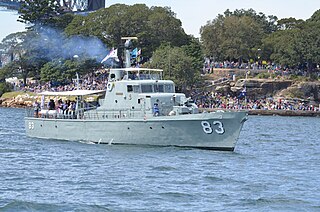
HMAS Advance was an Attack-class patrol boat of the Royal Australian Navy (RAN). Constructed during 1967 and commissioned into the RAN in 1968, Advance operated from Darwin and patrolled northern Australian waters.

HMAS Arrow was an Attack-class patrol boat of the Royal Australian Navy (RAN).
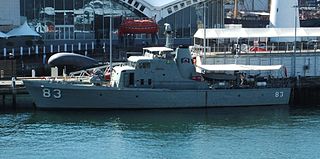
HMAS Samarai, named after the island of Samarai and its former town, was an Attack-class patrol boat of the Royal Australian Navy (RAN). Completed in 1968, the vessel was one of five assigned to the RAN's Papua New Guinea (PNG) Division. The patrol boat was transferred to the Papua New Guinea Defence Force in 1974 as HMPNGS Samarai. She remained in service until 1987, when she was paid off and used as a parts hulk.

HMAS Lae was an Attack-class patrol boat of the Royal Australian Navy (RAN). It was named for the city of Lae, capital of Morobe Province, Papua New Guinea. Completed in 1968, the vessel was one of five assigned to the RAN's Papua New Guinea (PNG) Division. The patrol boat was transferred to the Papua New Guinea Defence Force in 1974 as HMPNGS Lae. She remained in service until 1988.

HMAS Swan (U74/F74/A427), named for the Swan River, was a Grimsby-class sloop of the Royal Australian Navy (RAN) that served during World War II.
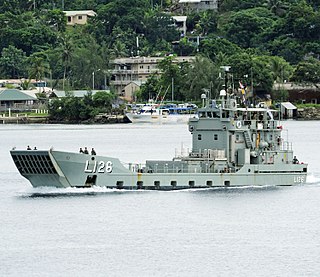
The Balikpapan class is a ship class of eight heavy landing craft. All eight were originally laid down by Walkers Limited for the Australian Army in the early 1970s. A reorganisation of watercraft responsibilities in the Australian military meant the landing craft were to be operated by the Royal Australian Navy (RAN), with seven commissioned directly into RAN service during 1973 and 1974, and lead ship Balikpapan transferred from the army to the navy. During the leadup to the independence of Papua New Guinea in 1975, two of the vessels were transferred to the new Papua New Guinea Defence Force (PNGDF).

There was considerable Axis naval activity in Australian waters during the Second World War, despite Australia being remote from the main battlefronts. German and Japanese warships and submarines entered Australian waters between 1940 and 1945 and attacked ships, ports and other targets. Among the best-known attacks are the sinking of HMAS Sydney by a German raider in November 1941, the bombing of Darwin by Japanese naval aircraft in February 1942, and the Japanese midget submarine attack on Sydney Harbour in May 1942. About 40 Allied merchant ships were damaged or sunk off the Australian coast by surface raiders, submarines and mines. Japanese submarines also shelled three Australian ports and submarine-based aircraft flew over several Australian capital cities.

The history of the Royal Australian Navy traces the development of the Royal Australian Navy (RAN) from the colonisation of Australia by the British in 1788. Until 1859, vessels of the Royal Navy made frequent trips to the new colonies. In 1859, the Australia Squadron was formed as a separate squadron and remained in Australia until 1913. Until Federation, five of the six Australian colonies operated their own colonial naval force, which formed on 1 March 1901 the Australian Navy's (AN) Commonwealth Naval Force which received Royal patronage in July 1911 and was from that time referred to as Royal Australian Navy (RAN). On 4 October 1913 the new replacement fleet for the foundation fleet of 1901 steamed through Sydney Heads for the first time.
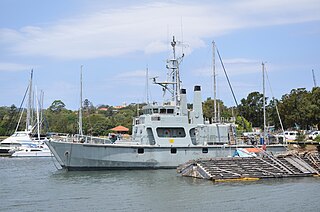
The Bay-class Minehunter Inshores were a class of catamaran-hull mine warfare vessels operating with the Royal Australian Navy from 1986. Also referred to as the MHCAT, the class was an attempt to produce a locally designed inshore mine warfare vessel. Two prototype ships were ordered in 1981, with the first ship, Rushcutter, commissioned in November 1986. The two ships experienced delays in construction, and the RAN resorted to acquiring six minesweeper auxiliaries (MSA) under the Craft of Opportunity Program to provide an interim mine-warfare capability, while also keeping Ton-class minesweeper HMAS Curlew in service until 1990, well beyond her intended decommissioning date. The ships did not enter service until 1993, due to problems with the sonar.

The harbour defence motor launch (HDML) was a 72 ft (22 m) long British-designed motor vessel used for harbour defence during World War II. Nearly 500 were built by numerous Allied countries during the war.

The Fairmile B motor launch was a very numerous class of motor launch produced in kit form by British boatbuilder Fairmile Marine, and then assembled and fitted out by numerous boatyards during the Second World War to meet the Royal Navy's coastal operation requirements.

Coastal Forces was a division of the Royal Navy initially established during World War I, and then again in World War II under the command of Rear-Admiral, Coastal Forces. It remained active until the last minesweepers to wear the "HM Coastal Forces" cap tally were taken out of reserve in 1968. The division received more gallantry awards than any other branch of the Royal Navy during that period.

HMAS Rushcutter is a former Royal Australian Navy (RAN) base that served as a depot, radar and anti-submarine training school located at Rushcutters Bay and Darling Point, in Sydney's eastern suburbs in New South Wales, Australia.

The Coastal Forces of the Royal Canadian Navy (RCN) was a specialized naval force of well-armed, small and fast motor launch (ML) and motor torpedo boat (MTB) flotillas, primarily manned by members of the Royal Canadian Naval Volunteer Reserve (RCNVR). Tasked with escort, coastal defence, anti-submarine, minesweeping and search and rescue duties, the Coastal Forces of the RCN contributed to securing Allied sea lines of communication off the coasts of Canada and Britain during the Second World War.
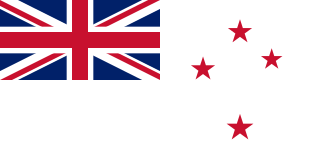
Coastal Forces was a division of the Royal Navy established during World War II. It consisted of small coastal defence craft such as motor launches, submarine chasers, air-sea rescue launches, motor gun boats and motor torpedo boats. It did not include minesweepers, naval trawlers or landing craft. This article is about the equivalent boats used in the Royal New Zealand Navy (RNZN).

HMAS HDML 1321, also known as Rushcutter was a 58-ton Harbour Defence Motor Launch (HMDL) of the Royal Australian Navy (RAN). Built by Purdon & Featherstone, Battery Point, Hobart, Tasmania and commissioned into the RAN on 11 November 1943, being the first Australian-built HDML to be commissioned and the last HDML in RAN service. She was assigned to Z Special Unit and delivered commandos for the 1945 ill-fated raid on Muschu Island. She was later reclassified as a Seaward Defence Boat and put into reserve after the war. She was recommissioned as HMAS Rushcutter in 1953 and used as an unarmed training vessel for the Royal Australian Naval Reserve and Australian Navy Cadets until 1970. Paid off in August 1971, she was converted to pleasure craft MV Rushcutter and is now based in Darwin.
HMAS ML 827 was a Fairmile B Motor Launch of the Royal Australian Navy.

The Canadian Fairmile B was a motor launch built during the Second World War for the Royal Canadian Navy. They were adaptations of the British Fairmile B motor launch design incorporating slight modifications for Canadian climatic and operational conditions. Eighty-eight were built in Canada for service with the Coastal Forces of the Royal Canadian Navy in home waters, of which eight were supplied to the United States Navy.


















